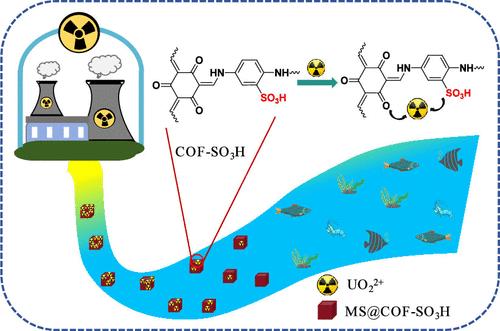以原位脱附海绵上的共价有机框架为整体材料去除超微量铀
IF 8.3
2区 材料科学
Q1 MATERIALS SCIENCE, MULTIDISCIPLINARY
引用次数: 0
摘要
本文在三聚氰胺海绵(MS)上原位制备了磺化共价有机框架(COF-SO3H),在室温水中通过一锅合成制备出 MS@COF-SO3H 整体材料,用于痕量含铀废水的便捷深度去除。COF 上的 -SO3H 能够通过强配位相互作用与 UO22+ 形成络合物,因此 MS@COF-SO3H 对 UO22+ 具有高选择性(Kd = 52603 mL g-1)。当初始 UO22+ 浓度为 100 μg L-1 和 5 μg L-1 时,MS@COF-SO3H-3 的吸附效率分别可达 97.9% 和 87.5%,最低残余 UO22+ 浓度低至 0.478 μg L-1,远低于之前的报道。此外,MS@COF-SO3H 作为吸附剂还具有优异的耐久性,即使循环使用 5 次,其对 UO22+ 的吸附效率仍高达 92.4%。MS@COF-SO3H 的制备条件温和,性能优异,很有希望成为一种高效的脱铀吸附剂。这项工作为方便地制备核废水深度处理吸附剂提供了重要线索。本文章由计算机程序翻译,如有差异,请以英文原文为准。

Ultratrace Uranium Removal by Covalent Organic Frameworks on an In-Situ-Decorated Sponge as Integral Materials
Herein, a sulfonated covalent organic framework (COF-SO3H) is prepared in situ on melamine sponge (MS) to produce MS@COF-SO3H as integral materials by a one-pot synthesis in water at room temperature, for facile deep removal of trace uranium-containing wastewater. The −SO3H on the COFs is able to form complexation with UO22+ through strong coordination interactions, and MS@COF-SO3H is therefore highly selective for UO22+ (Kd = 52603 mL g–1). The adsorption efficiency of MS@COF-SO3H-3 can reach 97.9% and 87.5% when the initial UO22+ concentration is 100 and 5 μg L–1, respectively, and the minimum residual UO22+ concentration is as low as 0.478 μg L–1, far lower than that in previous reports. In addition, MS@COF-SO3H exhibits excellent durability as an adsorbent, and its adsorption efficiency for UO22+ is still as high as 92.4% even after 5 cycles of recycling. The mild preparation conditions and excellent performance of MS@COF-SO3H make it quite promising as a highly efficient adsorbent for uranium removal. This work provides an important clue to prepare adsorbents facilely for nuclear wastewater deep treatment.
求助全文
通过发布文献求助,成功后即可免费获取论文全文。
去求助
来源期刊

ACS Applied Materials & Interfaces
工程技术-材料科学:综合
CiteScore
16.00
自引率
6.30%
发文量
4978
审稿时长
1.8 months
期刊介绍:
ACS Applied Materials & Interfaces is a leading interdisciplinary journal that brings together chemists, engineers, physicists, and biologists to explore the development and utilization of newly-discovered materials and interfacial processes for specific applications. Our journal has experienced remarkable growth since its establishment in 2009, both in terms of the number of articles published and the impact of the research showcased. We are proud to foster a truly global community, with the majority of published articles originating from outside the United States, reflecting the rapid growth of applied research worldwide.
 求助内容:
求助内容: 应助结果提醒方式:
应助结果提醒方式:


